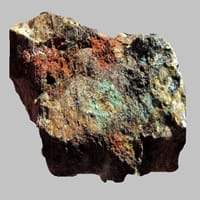Definition
Jasperoid is a rare, peculiar type of metasomatic alteration of rocks
Basalt is a common extrusive igneous rock formed by the rapid cooling of basaltic lava exposed at or very near the surface of Earth
Discoverer
Unknown
Georgius Agricola
Etymology
From silica, the main mineral content of Jasperoid
From Late Latin Basaltes (variant of basanites ), very hard stone, which was imported from Ancient Greek Basanites
Class
Sedimentary Rocks
Igneous Rocks
Sub-Class
Durable Rock, Medium Hardness Rock
Durable Rock, Medium Hardness Rock
Group
Not Applicable
Volcanic
Other Categories
Coarse Grained Rock, Fine Grained Rock, Medium Grained Rock, Opaque Rock
Fine Grained Rock, Opaque Rock
Texture
Earthy
Glassy, Massive, Porphyritic, Scoriaceous, Vesicular
Color
Black, Brown, Colourless, Green, Grey, Pink, White
Black, Brown, Light to Dark Grey
Durability
Durable
Durable
Scratch Resistant
Yes
Yes
Appearance
Glassy or Pearly
Dull and Soft
Interior Uses
Decorative Aggregates, Floor Tiles, Homes, Interior Decoration
Floor Tiles, Homes, Hotels, Kitchens
Exterior Uses
As Building Stone, Garden Decoration, Office Buildings, Paving Stone
As Building Stone, Paving Stone, Garden Decoration, Office Buildings
Other Architectural Uses
Curbing
Curbing, Whetstones
Construction Industry
As a Flux in the Production of Steel and Pig Iron, As a Sintering Agent in Steel Industry to process Iron Ore, As Dimension Stone, Cement Manufacture, for Road Aggregate, Making natural cement, Manufacture of Magnesium and Dolomite Refractories, Production of Glass and Ceramics, Serves as an Oil and Gas Reservoir rock
Arrowheads, As Dimension Stone, Cobblestones, Cutting Tool, Rail Track Ballast, Roadstone
Medical Industry
Taken as a Supplement for Calcium or Magnesium
Not Yet Used
Antiquity Uses
Artifacts, Jewellery, Monuments, Sculpture
Artifacts, Monuments
Commercial Uses
An Oil and Gas Reservoir, As a Feed Additive for Livestock, Gemstone, Metallurgical Flux, Production of Lime, Soil Conditioner, Source of Magnesia (MgO)
An Oil and Gas Reservoir, Commemorative Tablets, Creating Artwork, Used in aquariums
Types
Not Available
Alkaline Basalt, Boninite, High Alumina Basalt, Mid Ocean Ridge Basalt (MORB), Tholeiitic Basalt, Basaltic trachyandesite, Mugearite and Shoshonite
Features
Host Rock for Lead, Traps for subsurface fluids like Oil and Natural Gas., Zinc and Copper Deposits
Has High structural resistance against erosion and climate, Very fine grained rock
Archaeological Significance
Famous Monuments
Data Not Available
Easter Island in the Polynesian Triangle, Pacific Ocean, Gateway of India in Mumbai, India, Gol Gumbaz in Karnataka, India
Famous Sculptures
Data Not Available
Data Not Available
Formation
Jasperoid is a rare and peculiar type of metasomatic alteration of rocks. It is formed by extreme alteration of wall rocks within a shear zone which may occur in sediments, andesites, trachytes and basalts.
Basalt forms when lava reaches the Earth's surface near an active volcano. The temperature of lava is between 1100 to 1250° C when it gets to the surface.
Mineral Content
Clay Minerals, Pyrite, Quartz, Sulfides
Olivine, Plagioclase, Pyroxene
Compound Content
NaCl, CaO, Carbon Dioxide, Magnesium Carbonate, MgO
Aluminium Oxide, CaO, Iron(III) Oxide, FeO, Potassium Oxide, MgO, MnO, Sodium Oxide, Phosphorus Pentoxide, Silicon Dioxide, Titanium Dioxide
Types of Metamorphism
Burial Metamorphism, Cataclastic Metamorphism, Regional Metamorphism
Contact Metamorphism
Types of Weathering
Not Applicable
Biological Weathering
Types of Erosion
Not Applicable
Not Available
Grain Size
Medium to Fine Coarse Grained
Fine Grained
Fracture
Conchoidal
Conchoidal
Streak
White
White to Grey
Porosity
Less Porous
Less Porous
Luster
Vitreous and Pearly
Not Available
Cleavage
Perfect
Not Available
Specific Gravity
2.8-3
2.8-3
Transparency
Transparent to Translucent
Opaque
Density
2.8-2.9 g/cm3
2.9-3.1 g/cm3
Resistance
Heat Resistant, Pressure Resistant, Wear Resistant
Heat Resistant, Pressure Resistant, Wear Resistant
Deposits in Eastern Continents
Asia
China, India
India, Russia
Africa
Morocco, Namibia
South Africa
Europe
Austria, Italy, Romania, Spain, Switzerland
Iceland
Others
Not Yet Found
Not Yet Found
Deposits in Western Continents
North America
Mexico, USA
Canada, USA
South America
Brazil, Colombia
Brazil
Deposits in Oceania Continent
Australia
New South Wales, Queensland, Yorke Peninsula
Not Yet Found
All about Jasperoid and Basalt Properties
Know all about Jasperoid and Basalt properties here. All properties of rocks are important as they define the type of rock and its application. Jasperoid belongs to Sedimentary Rocks while Basalt belongs to Igneous Rocks.Texture of Jasperoid is Earthy whereas that of Basalt is Glassy, Massive, Porphyritic, Scoriaceous, Vesicular. Jasperoid appears Glassy or Pearly and Basalt appears Dull and Soft. The luster of Jasperoid is vitreous and pearly while that of Basalt is not available. Jasperoid is available in black, brown, colourless, green, grey, pink, white colors whereas Basalt is available in black, brown, light to dark grey colors. The commercial uses of Jasperoid are an oil and gas reservoir, as a feed additive for livestock, gemstone, metallurgical flux, production of lime, soil conditioner, source of magnesia (mgo) and that of Basalt are an oil and gas reservoir, commemorative tablets, creating artwork, used in aquariums.










